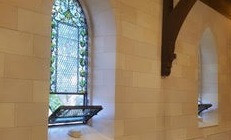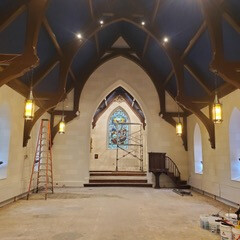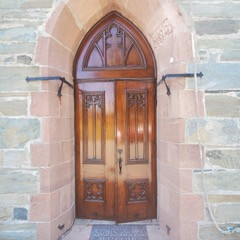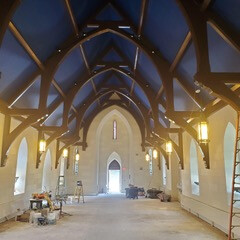"The begging question"
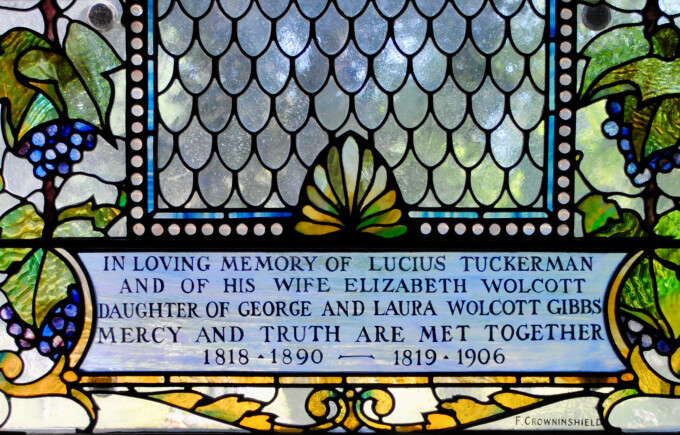
During the past several weeks, I have been thinking as much about the nature of the St. Mary's community and the hopes of the founder Sarah Gibbs as the begging question, “When will the oak flooring actually arrive?”
Perhaps this line of thought has resulted from simultaneous reading of C. S. Lewis’s book Mere Christianity and researching the land evidence records which provide no clear evidence of land dimensional holdings back to the first transfer to George and Walter Channing, as tenants in common, from John Faxon on December 14, 1796. If your name was Clive Staples Lewis (1898-1963), you, too, might use “C. S. Lewis” in all your published writings. Of course, as an Oxford and Cambridge scholar and a one-time atheist, his writings became some of the most influential in the twentieth century and the most popular is the Chronicles of Narnia. Maybe his unique intellect allowed him to see clearer the ideals of Christianity.
Sarah got her land holdings of the so-called Potter Farm where the church allegedly sits, on April 9, 1844, after paying $5,250.00 for approximately 88 acres. She was sixty plus when she began this spiritually inspired project. And then she spent the next twenty plus years, till her death at age 84, working to have her vision of not only a church but a seminary realized. The church was realized but not the seminary. And in the early years of the church the first rector, the Rev. Hobart Williams, came and left at least three times during her life to be replaced by other rectors before his return. Sarah had to feel some degree of disappointment and frustration, but she endured and remains an inspiration for us as we await the church restoration completion and endure a recent factory communication of a new delivery date of the wood flooring, discussed below.
So please allow me to digress from my thoughts on the St. Mary's community until the end of this note, for an update on the progress of our historic church restoration, the principal reason for writing these bi-weekly notes.
As shared in my last note, the macro-progress was completed last week with the completion of the interior painting after months of repair and the plastering of the walls and ceiling. And it looks great, overcoming my initial fears of the wrong color palette. Also thanks to our interior decorator and the visiting artists who assessed and reinforced the exactness of the scored lines for the faux stones and the color matrix, it is indeed impressive. This week we have been touching up a few areas that needed correction after the new lighting was installed and finishing the narthex entrance interior on the south side of the church.
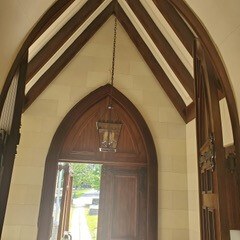
We also have finished the external knee walls, with the craftsmen of Yardworks, Inc., that allow safe entrance and exit from the northern basement doors. Prior to this aspect of the project, the soil from the banks encroached, so that the doors could not open properly. After the West Warwick Station Fire, egress is a principal concern for building code safety and certificates of occupancy. This is a picture of the area before the walls.
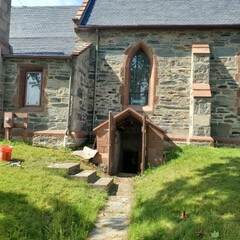
And this is a picture of the finished walls.
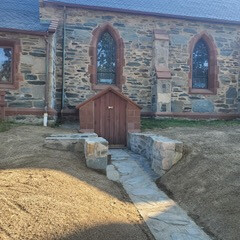
These walls can only be seen from the cemetery to the north of the church or on the road around the church which is now closed for construction.
In another small project continuation, Fish, our expert mason, will restore the brown stones around the south narthex doors and the bridal door next week with a very close brown stone mortar match.
If you get off the ramp from the Newport Bridge, you may observe Aardvark Antiques with their many outdoor ornaments and sculptured animals. Arthur Glover, who founded Aardvark many years ago has remained in business over the years providing not only beautiful antiques but extraordinary craftmanship of railings and antique fences.

The solid plywood railing that was in place has now been removed and replaced by master craftsman with a new metal railing.

Aardvark has provided service to not only individuals, schools and churches but the Preservation Society as well over the years. Ray Gray, the white-haired individual on the right, in the picture, is a master craftsman and his assistant Mike Billings is to his left. The railing will be primed and painted before returning after the flooring has been installed. They brought the railing to the site for a measurement of the gate at the end before the steps that is required, again for safety.
The altar railing at the front of the church has been installed in its new position and will make the communion service much easier for both the congregation and the rector, as there will be no steps to climb.
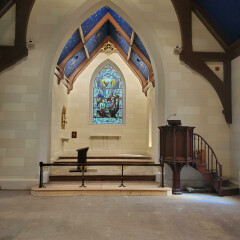
This area and the whole area around the altar in the chancel will be covered with the selected blue carpet, and kneelers will be in place as well for future communion services.
The church has thirteen beautiful stained-glass windows. The painting of the window sills and the interior frames in the historic antique white color rather than the dark brown has allowed them to “pop” and reflect their colors brilliantly. On the north side there are four windows as shown in the picture, each in memory to a member or members of the Gibbs family or the family of Laura Wolcott Tuckerman, who married a son of George III.
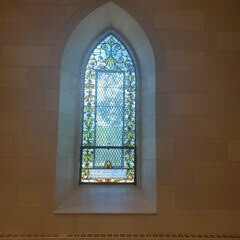
On the south side of the church there are four biblical stained glass windows, equally as beautiful, in memory of familiar names like Lawton.

There are three windows, one on each side of the bridal door and one above in the back of the church facing west, in memory of the Tuckerman family members. Just as Wolcott is a familiar street in Middletown, so is Tuckerman. It is interesting to note here that after the death of George and Mary Gibbs, who died after George in 1824, the Gibbs family owned all the land from Rhode Island Ave. to Easton Pond and from First Beach to Second Beach. Gibbs Avenue in Newport is the most- known street named after the family.
The final two stained-glass windows are in the chancel, the largest window in the church above and behind the altar.

A smaller window is in the chancel area on the south wall as well.
With the new lighting our hope is that the large stained-glass window behind the altar will be lighted from the inside of the church and seen from East Main Rd. as well as much more brilliantly internally with the new wash of light. It is also hoped that the refinished crown at the peak of the interior arch of the chancel will provide simplistic beauty and spiritual elegance as in the original historic design of the church.
So now the important question of when will the oak flooring arrive?
This is now the essential next step for this restoration, so that we can install the carpet, re-install the refinished pews, install the new organ, and celebrate the reopening of the historic St. Mary's Church. The wood manufacturer's communication months ago was that the wood would arrive onsite either the last week in August or the first week in September. Well, the last week in August has come and gone with no wood onsite. Now in response to our constant inquiries of the wood company, we have been told this week that the oak flooring goes into the kiln in Texas the first week in September and now will ship the second week from Texas probably arriving at our church the week of September 12. I have found arguing with a Texan is usually a futile exercise.
So, our flooring schedule will slip several weeks at least. But that does not mean we will not have the project finished in October, our six-month goal of completion, which is still very likely. It does mean that we will need to compress the future work after the floor is completed. It also means we will not know the exact date of completion and restoration celebration until we actually have the wood onsite.
So, during the next several weeks, while we await the delivery of the wood flooring, we will do small “punch-list items” but nothing significant or dynamic. The floor installing subcontractor is ready when the wood arrives. As everyone knows today, these supply chain delays, despite earlier promises, are all too common in construction and require patience. Patience may be a Christian virtue but one that does not come easily for me.
There are several other supply chain delays or long lead issues that we must accept and that we knew from the start. But they should not stop us from celebrating the completion and reopening of the church. The first is the new mixer for the newly installed sound /acoustic system which will be delayed as will be the new microphones and a connection for the installed camera which all require unavailable microchips. We have two companies trying to resource alternatives but it looks doubtful till the microchips are freely flowing. We intend, if the items are not on hand when restoration work is finished in October, to utilize our existing sound components for a functioning sound system until the new parts are available. We do plan to install both the new speakers for the organ and the acoustic/sound speakers which are now here the second week in September as the wiring was completed before the walls were repaired and painted.
In addition to the sound components, we have been told that the new choir chairs are on a long lead delivery time and the new pew cushions will arrive sometime later than the expected completion of the restoration. Both of these items can be handled, though, and not interfere with an opening service though sitting on a hard pew may not be as luxuriously comfortable as when the new tufted pew cushions are installed. But then again, we might appreciate the cushions more after experiencing what was obviously a historic condition of “hard seat” endurance in the historic church.
So, allow me to conclude with my thoughts on the nature of this St. Mary's community begun by Sarah Gibbs. As a long-time resident of Portsmouth and long-time friend of many parishioners and the former rector Gordon Stenning, I have observed and admired from a distance a sense of the special religious community that has existed at St. Mary's. As we have now become part of your community, it has become much clearer and even more profound. You have a very unique and special community that I am sure Sarah Gibbs once dreamed might become a reality and which drove her vision. As someone who has experienced many communities in business, politics and other non -profit worlds, don’t ever underestimate how significant and special this community of Christian spirit is at St. Mary's.
From your rector to the individuals who donate food or grow gardens, knit a prayer shawl or prepare meals for special events or just say “hello” to new worshippers, there is the presence of true Christian spirit that C. S. Lewis articulates in his book. I was not certain of this spirit, when asked as a very new member to take on this restoration oversight. And when the scope of the project and the cost were discussed, it was not clear to me that it was even possible within the budget or that there existed an ability within the congregation to raise the necessary funds to avoid an unacceptable burden on the annual operational church budget. But the vestry and the rector shared their faith that it was possible and indeed it has come to pass.
Now as we approach the end phase of this project, there has been no fighting or complaining but quite the opposite and the members of this special community have quietly and generously shared their money to accomplish this project in an exceptionally caring way, withholding much fanfare or organizational stressful efforts. Sarah Gibbs would be very proud of St. Mary's Church today as it exhibits all that she hoped to achieve with her church in southern Portsmouth.
All of which is to say, we have now observed first hand that this St. Mary's community exhibits extraordinary and special Christian qualities in what C. S. Lewis shares as the theological virtues: faith, hope, and charity. We do this not just in the abstract on Sunday morning but in the everyday operations and interactions with members and others within the community. Perhaps this is a reason so many others have recently joined when other churches are in fact losing membership. So, onward to the finish line of this restoration project, whatever the exact date, with a renewed appreciation of the Christian spirit begun by Sarah Gibbs and continued today by the St. Mary's community and leadership! Anon
